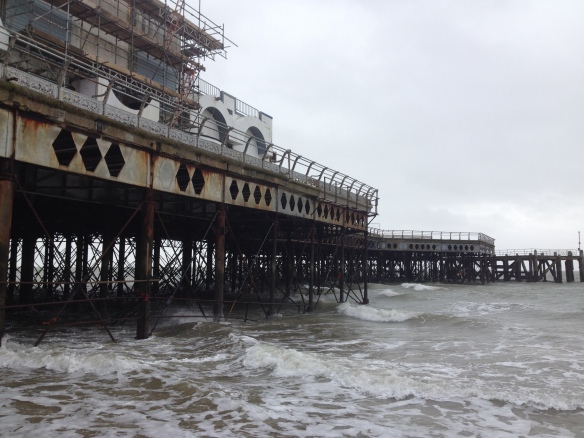
I feel sorry for the pier today. Storm Gertrude is battering the north of England and Scotland, but we only have a stiff breeze here in Portsmouth. Still, loose boards flutter and the waves crash around the rusty pilings.

But I’m not sorry for the pier’s disrepair, I’m sorry that it is being held together; sorry that it is required to hold so much longing. It reminds me of this tree in Savernake forest. Old beyond the span of its years, no longer strong enough to hold its own weight, but we will not let it die.
South Parade Pier is a little over a century old and has been destroyed by fire twice in that time. Yet it holds the optimism of a rapidly expanding city and seaside resort so that local residents fight to keep it standing long after the boats it was designed to received have stopped running. The business model of the pier is all based on food and entertainment, which can be supplied elsewhere, even on the seafront – without the overheads of a structure built out into the sea.

But it calls to people; reminds them of happiness, of being carefree, of being a bustling seaside resort. After several owners let the structure degrade until it was unsafe, locals formed a group to ‘save the pier’. Their aim was to force sale of the pier to themselves, and to bring it back into use. They collected signatures, and comments on their website and held an open day with Portsmouth University and Heritage Lottery Fund backing to explore and support local aspirations for the structure.

In the end, the current owners agreed to fund repairs, rather than sell to the heritage group, and they have spent the last 18 months working. The council no longer list it as an unsafe structure. But it clearly has a long way to go before it can be used, can generate income, can fulfil those desires so longed for.
Meanwhile the council is seeking extra funding to stabilise Southsea’s sea defences because a major hole has developed about 100m west of the pier. The predicted rise in sea levels over the next 75 years will leave the whole seafront, the pier, and much of the city under water. Of course, we can be hopeful that the impacts of climate change may yet be reduced. We can plan responses to sea level rise. But we can’t bring back the time when the seafront brimmed with the optimism of pleasure cruises, simply by repairing the pier.

So how should archaeologists respond to this situation? Most would agree that we should support local people in their desire for repair. But I think we have another role, another challenge. The challenge for archaeology is to use these kinds of changes to help people see, and respond to the wider changes in our world. If we want to reduce the impacts of climate change, we will have to change our lives. We will not be able to keep everything. We will have to let some things go.
As we work so closely with material that has survived many changes, archaeologists often have the strongest desire to see that material continue to survive. But the questions we follow, the stories we tell are all about the change. We have a vast treasure trove of resources for understanding how change works, how societies survive and even thrive despite the loss of much that may have felt central to their lives.
So we need to do more than supporting local people when they want to hold on. We need to tell the stories of the changing places, enrich the fantasies of innocence and grandeur with the excitement of transformation. To learn and to teach the letting go that is at the heart of change. That’s the grand challenge I see for my archaeology.

I agree with your analysis and the challenge proposed. However, I don’t think the reflective nostalgia in your conclusion is necessary: “We will have to let some things go.” For me, it is more like “We have the opportunity to let places grow – and learn”. (And here we are back to the parental metaphors!)
Thanks Cornelius, I agree that not all change is loss and that we can celebrate the removal of material where it leads to changes that we want (letting the place grow and develop) But I also think that there are losses we are facing into, things we would rather keep but can’t (like a reliance on fossil fuels) learning that we can survive and be happy despite losses is one of the things that archaeology can offer if its done right. So sometimes archaeologists could help people let go of something they want to keep. Like declutters.
Pingback: What do we, archaeologists, see as our grand challenges | Doug's Archaeology